|


by Barry M. Warmkessel, Ph.D.
2004
The Vulcan Team
(edited by Joan d’Arc)
from
ParanoiaMagazine Website
Vulcan is the distant, yet to be
observed, dark star companion of the Sun. It has flavored our
collective culture, sparked religious wars, aided in the
manifestation of avatars like Christ and Buddha1 and stimulated
quasi-periodic bombardment of Earth by comet strikes, redirecting
the course of human civilization.
Vulcan could be the Infrared Astronomical Satellite (IRAS) object
discovered in 1983, or it could be within 15 degrees in right
ascension and 9 degrees in declination of this object. This and
other data have been utilized to determine Vulcan’s mass and orbit.
Our research paper entitled "Earth’s Bleak Future"2 estimates that
Vulcan orbits the Sun in slightly less than 5,000 years in a very
eccentric orbit that is highly inclined to the ecliptic plane.
It is
anticipated to be a Jovian-sized Protostar (called Vulcan by the
Theosophists) 141 to 165 times Earth’s mass, black or red in color
and dense like Earth. Vulcan is very faint, about magnitude 21,
comparable to the objects investigated by IRAS analysts.3
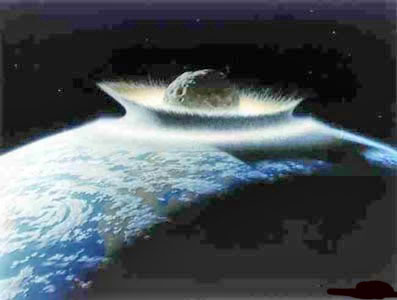
We initially determined Vulcan’s orbit
with the aid of the Tzu Wei, a form of Chinese astrology, as well as
other physical data.4 Interestingly, Professor
George Forbes arrived
at a value of 5000 years for the period of an undetected planet in
1880. He used the aphelion (the point farthest from the Sun) of
multiple long-period comets to predict an undiscovered planetary
orbit similar to Vulcan’s orbit in terms of period, inclination and
node. It is important to note that the Vulcan Team does not suggest
that the dark star comes anywhere near the inner solar system but,
rather, it casts comets from the Kuiper Belt into near Earth orbits.
Vulcan never gets closer to the Sun than about 2.7 times as far as
Pluto’s farthest point.
Our online paper entitled "Vulcan, Comets and the Impending
Catastrophe"5 indicates that Earth is vulnerable to quasi-periodic
comet bombardment. These giant comets sometimes fragment while
rounding the Sun and form comet swarms that pass through the inner
solar system, some impacting Earth. We find that four (or more)
comet swarms have formed at two distant (444 AU) locations separated
by 13 degrees in Vulcan’s elliptical orbit. (AU=Astronomical Unit,
Sun to Earth)
Long-period comets may have struck Earth approximately 5,200 and
11,600 years ago, causing Noah’s flood and our current warm
interglacial period, respectively. The latter date coincides with Plato’s date for the destruction of Atlantis.
Sir Fred Hoyle,
Britain’s recently deceased royal astronomer, postulated that meteor
strikes averaging 10,000 years apart are responsible for initiating
and terminating Ice Ages. Warm interglacial intervals, lasting about
10,000 years, are found interspersed in the Ice Ages. This interval
is loosely related to comet impacts when Vulcan is near aphelion;
specifically, it is related to both the location of Vulcan and the
periodicity of the Vulcan-induced comet swarms.
"Earth’s Bleak Future"2 explores geo-climatological data (resulting
from past comet impacts) over the past 14,000 years and correlates
it with quasi-periodic impact intervals predicted by our theoretical
estimates of Vulcan’s mass and orbit. Vulcan’s orbital period (and
eccentricity) can also be independently calculated from this data.
The combined analysis indicates that Vulcan’s period is between 4969
(theoretical) and 4992 (geo-climatological) years. These procedures
can also be used to approximately estimate when threatening comet
swarms may next appear.
The Bible is full of warnings of future comet or asteroid impacts,
most importantly from Christ as found in the New Testament. Peter
3:5-13 and Revelation 20:7-15 suggest a final cataclysmic event
wherein the Earth is turned into a sea of fire and lava. (Such a
catastrophe seems to have befallen Venus a few million years ago.6)
Biblical sources (Matthew 24:21, Revelation 6:12-17, 8:5-13,
16:17-21 and 18:8-10,21 etc.) suggest that a smaller comet will
impact a ’thousand years’ (Revelation 20:1-6) before the final
event.
Unconventional sources indicate the probability of multiple comet
strikes or near misses within the next 126 years. Two independent
sources indicate that these events may start as early as 2006-2007,
with other impact events following in the next 6 to 120 years. At
most, a five-month visual warning is anticipated.
Crop Circle T367 - A
Current Warning
Our research also postulates that extraterrestrials (ET) would be
keenly aware of Vulcan, and could even use its gravity to slow their
spaceships’ trajectory as they settle into an orbit within the solar
system, and/or "sling-shot" their spacecraft
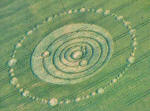 homeward
when they leave. Precise knowledge of Vulcan’s mass and orbit would
be required for such maneuvers. This, combined with the localization
of a threatening comet swarm by debris detection gear (postulated to
be used by ET spaceships), would permit them to precisely know when
the Earth would be at risk from a comet impact.7 homeward
when they leave. Precise knowledge of Vulcan’s mass and orbit would
be required for such maneuvers. This, combined with the localization
of a threatening comet swarm by debris detection gear (postulated to
be used by ET spaceships), would permit them to precisely know when
the Earth would be at risk from a comet impact.7
Crop Circle T367, which appeared near Cheesefoot Head in England in
1995 (click image left), may represent an ET warning. The planets shown are
disproportionately large but the orbits are to scale. The "small
white spots" (four objects, one broken in two, totaling five) called
"grapeshot" are depictions of meteors or comets. The "missing" Earth
(its orbit is still depicted) signifies its devastation by the
anticipated strikes.
The relative locations of the planets and the
precise location of their perihelion
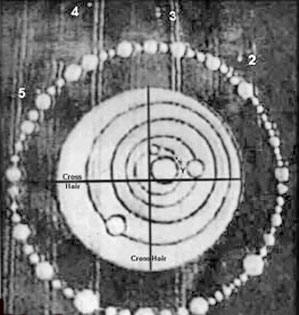 (closest
orbital point to the Sun) define the date of this future event to
within a few days. Dr. Robert H. Hadley, professor of physics and
astronomy, analyzed this crop circle in detail in the winter 1995-96
issue of Colin Andrews’ CPR International Newsletter. (closest
orbital point to the Sun) define the date of this future event to
within a few days. Dr. Robert H. Hadley, professor of physics and
astronomy, analyzed this crop circle in detail in the winter 1995-96
issue of Colin Andrews’ CPR International Newsletter.
Dr. Hadley’s analysis concludes that someone created this crop
circle with precise knowledge of the solar system and with a skill
that permitted it to be formed at an unusual hillside angle. This
crop circle has another unusual feature: the Sun and planets are
off-center. In our analysis, the center of the circle is defined by
the cross hairs added to the crop circle image.
The misalignment
between the centroid and the Sun is presumed caused by the
Sun-Vulcan center of mass. Assuming this circle defines the
barycenter (center of mass) of the Sun-Vulcan binary system, it is
offset toward IRAS 1732+239, an astronomical object that could be
Vulcan.
Crop Circle T367 (click image right)
can be interpreted as follows:
The "grapeshot"
represents the incoming comet swarm originating from its resonant
orbit position in Vulcan’s orbit. The configuration of the inner
planets represents a date when the threatening comet swarm may first
appear. According to our analysis the comet cluster may first appear
about 25 February 2007. The grapeshot indicates how many comets
threaten Earth. The appearance of the comets will get our attention,
but by then it would be too late to take effective countermeasures.
The
Bible Code - A Historic Warning
A second source of impending comet strike data has been found in a
new and unusual interpretation of the Hebrew Pentateuch called the
"Bible Code." Here, all the Hebrew letters found in a book in the
Bible are strung without word or page breaks and rastered in 64
columns. A computer is used to search for words in a horizontal,
vertical or diagonal format. Skip sequence words are searched (every
other row or column is skipped) and viable words are found.
Many
skip codes exist, like 4, 10, 50, etc. Words cross other words or
are found in the matrix vicinity of other words. It is postulated
that these word groups are related. Even the name given to the Sun’s
dark star companion (Vulcan) is specifically mentioned in the Bible
Code:
-
Dark Star - star/planet - star - Sun
- companion - object - invisible/concealed - concealed -
emerging - amalgamation - granular/nuclear - turmoil
-
Tsunami - Vulcan - planet/star -
India - Indian - Athens - Greece - tsunami - stony - flaming -
gigantic - flame - obliterate - flabbergasted - leviathan -
oblivion - overwhelming - impact
-
Incoming Asteroid - Vulcan - blaze -
brightness - whole Earth - USA - impact - billion - missile -
nemesis/vengeance - disaster/holocaust
A variety of events are also revealed,
including victories and defeats of political figures,
assassinations, atomic holocausts, earthquakes and comet/asteroid
strikes. President Clinton’s election and the unexpected victory of
Prime Minister Netanyahu were predicted. The "kicking out of a
President" due to "Watergate" was revealed. Details of the
assassinations of Yitzhak Rabin, Netanyahu (delayed), President
Kennedy and R. F. Kennedy were found.
Great earthquakes found in the
Bible Code include the 1906 San Francisco quake, the 1976 China
quake, the 1994 Los Angeles quake and the 1995 Kobe Japan quake.
Earthquakes predicted include a 2010 Los Angeles quake, a Japan
quake expected in 2000 and/or 2006, and a 2013 quake at an
unspecified location.
The Bible Code claims that an asteroid killed the dinosaurs (some
now think multiple comet hits wiped them out). It also predicted the
comet Shoemaker-Levy (SL9) would pound
Jupiter on 16 July 1994. The
Bible Code predicts that the Swift-Tuttle comet will re-appear in
2126, but will miss Earth because it "comes in the seventh month."
In fact, the International Astronomical Union had issued a low-key
warning of a potential collision between Swift-Tuttle and Earth
based on its 2126 return. This warning was rescinded when new data
indicated it would safely pass in late July, not mid-August as was
first estimated.
Long-period comet strikes are the important message of the Bible
Code. An impact from a comet one kilometer in diameter would release
a 300 Gigaton blast and create a tidal wave 300 feet high. Such a
strike could annihilate the bulk of humanity by starvation via
climate change. The climate could remain changed for millennia and
the biosphere could be rendered temporarily acidic.
The orbits of Vulcan and the comet swarms are locked together. When
Vulcan goes around twice, the comets go around thrice. Their periods
are in a stable 3:2 resonance about ten thousand (9,938) years
long.8 Alexander Tollmann9 dates seven impacts to approximately 7910
and 7810 BC, when the celestial geometries between Vulcan and the
Sun were much like they are now. This configuration moves the inner
solar system farthest from the Sun-Vulcan barycenter. The
theoretically projected impact dates are 2028 and 2128, with seven
double-sourced predictions of impacts or near misses occurring
about:
2006-7,
2011-13, 2015-16, 2030-31, 2044-45, 2071 and 2120-30.
According to Bible Code, the first comet event occurs in 2006. Wars
and economic crises relating to the strike follow. The Bible Code’s
2006 event is proximate in time to the Crop Circle T367 event of
February 2007. The T367 crop circle image shown here is believed to
suggest the range and the date when the next threatening comet swarm
first becomes visible, but it could also indicate when Earth
(India?) may be hit.
Multiple impacts are predicted to "annihilate Earth" around
2012.
(The
Mayan calendar ends
21 December 2012.) The Bible Code predicts
that this comet will be crumbled as it passes around the Sun, as was
the SL9 comet as it passed Jupiter. Many of SL9’s fragments made
spots on Jupiter larger than the Earth. One of the comets (#3 shown
in Crop Circle T367) is a double, and perhaps has already been
crumbled.
Alternately, it may be crumbled in Earth’s atmosphere.
Another comet may cause tsunamis and fiery hail before and after its
fragments strike the Mediterranean basin. One, according to
Nostradamus, strikes the Aegean Sea off Evvoia destroying ancient
Greek and Roman structures in the month of October shortly after the
new millennium. This event is predicted for approximately 2015-2016.
Zechariah 14:4 foretold an event causing a fracture extending from
the Dead Sea to the Mediterranean, about 45 miles long. This comet
could come from a northerly direction or out of the southeast going
northwest if it rounds the Sun first. The shock of its passage
through the atmosphere could produce large quantities of (sour)
nitric acid, poisoning lakes and streams. The Israel meteorite seems
to be one of about "super-tanker" size. A 500-meter fragment would
make an impact site about a hundred miles wide. Israel would be
thrice annihilated: by direct strike, tsunamis, and starvation
(Isaiah 13:12 and Daniel 2:24-45).
The real killer is predicted to be from a three-mile diameter comet
that will produce a sixty-mile wide crater. Double sourced data
suggest that it (and its fragments) will impact Canada, Ohio and/or
New York around 2044-45 (other analysts suggest 2010-2013). It is
believed that this impact will set off the Yellowstone
super-volcano. Other impacts may follow, with coinciding predictions
of 2120-2130, but humankind may be devastated by then.
Mass and
Orbit of Vulcan
George Forbes was the first to predict hypothetical planetary orbits
from the aphelion of trans-Neptunian comets in 1880. Forbes
predicted a planet with orbital parameters similar to those of
Vulcan’s. He also predicted a planet at 87-122 AU with a 1,076-year
orbit. In his 1994 book,
ASTRO-METRICS, Yari Danjo1 predicted a
planet he called Septimus at 154 AU.
Perhaps the same planet, Danjo
considered Septimus to be spawned by interaction between the Sun and
Vulcan. His analysis indicated that Septimus is Earth-sized.
Astronomer Clyde Tombaugh searched for these planets and concluded
that none existed brighter than magnitude 16.5.
By 1987, Van Flandern and Harrington suggested
Planet X (Vulcan?)
might be in a highly elliptical orbit. Several media releases
between 1982-1987 suggested that the Sun has a dark star companion
that causes periodic meteor bombardment of Earth. The IRAS search
found three unknown objects but two may have been later identified
(as gas clouds, galactic objects, etc.). (Nature, May 1984) Which
two was not specified, but Vulcan is believed to be at or near one
of these three: IRAS object 1732+239.
The IRAS launch was timely. Perhaps authorities had been "tipped
off" to Vulcan’s existence by examining reported data from ETs, as
was Danjo.1 The IRAS was placed in orbit in 1982, after
Sir Fred
Hoyle proposed in 1981 that meteor impacts cause Ice Ages.
Surprisingly, he failed to consider that a distant planet in a
highly elliptical orbit could cause frequent bombardment of Earth.
Incidentally, the star map shown to
Betty Hill 10 when taken on board
a flying saucer in 1961 and Crop Circle T367 are not the only cases
where extraterrestrials have provided evidence of the
solar system’s
dark star. An unpublished case occurred on 6 October 1974, when an
individual was invited to board an ET craft and seemed to know a
little of astronomical symbols. He was not mesmerized, but remained
lucid during the event and prepared a report afterwards. Contained
was an example of the ET’s interpretation of our alphabet and a
description of the solar system that included our Sun’s companion
star.11
Historical Data Supporting Vulcan and the Comet Swarms
The ancients had descriptions of Vulcan and the comet swarms. In
The
12th Planet, Zecharia Sitchin displays a clay cylinder seal
(VA/243) from the Akkadian civilization of Mesopotamia 4,500 years
ago, showing globes of various sizes orbiting the Sun. What makes
the Akkadian Seal so unique is that the sizes are given. There are
three small planets representing Mercury, Venus and Mars (Earth and
Moon are not shown).
Shown are the Jovian planets with their
diameters in scale to the logarithm of their known masses. Uranus
and Neptune are depicted along with three larger planets, two of
which represent Jupiter and Saturn. We interpret the more distant
large planet to represent the dark star, Vulcan. Logarithms were
unknown to the ancients, therefore, this data could only have come
from an ET source. The mass depicted for Vulcan is consistent with
the T367 Crop Circle barycenter and the quasi-periodic impact
intervals found in Earth’s geo-climatological history.
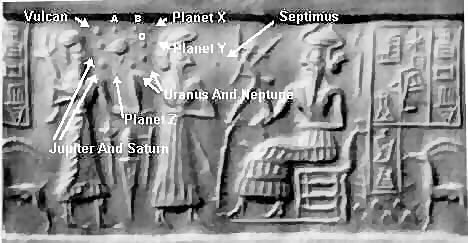
Sitchin anticipates an object called
Marduk in an elongated elliptical orbit reaching from deep space to
the inner planets. Its 3,600-year period is close to our comet
swarm’s 3,313-year average period. We think the Babylonians knew of
two comet clusters (within a comet swarm) and named them Marduk
(a.k.a. Phaeton) and Tiamat. Marduk was recorded as a major
astronomical entity with four "attendants" (five total, as depicted
in Crop Circle T367) and Tiamat with eleven or more.
An apparent
"battle" occurred as Tiamat rounded the Sun and met incoming
Marduk.
A major comet, Kingu, is also shown. People living near Ardmarnoch
in western Scotland may have seen this event about 10,000 years ago.
They carved its (or Tiamat’s) image on a large flat rock. Twenty-two
comet-like objects are arranged in a cluster as if a comet had
fragmented while passing around the Sun.
European and Asia Minor traditions indicate that Marduk (and its
debris) struck from out of the northwest (from Vulcan’s aphelion).
Persian (Zoroastrian) tradition claims that Tistrya (Phaeton) came
out of the constellation Cancer. Three to five fragments struck the
Earth in rapid succession: in northeastern Siberia (close to the
mammoth graveyards), in Point Barrow and Harrison Bay, Alaska, and
in the Old Crow Plains in Yukon, Canada.
Huge hills of
sub-fossilized and carbonized wood indicate that one strike was in
the Arctic Ocean between Siberia and Alaska. The fragments may have
reached the Carolinas. However, this may have been the result of an
earlier strike that formed the Carolina bays and also left a large
impact crater on the ocean floor near Bermuda.
Meteor/Comet Bombardment
In his book,
ICE: The Ultimate Human Catastrophe,
Sir Fred Hoyle
claimed that even a 300-meter meteor strike could initiate a
worldwide Ice Age. Hoyle proposed that meteors (or comets) are
responsible for both the rapid onset and termination of Ice Ages, as
well as the variations of global ice levels found in the Ice Ages.
Normally, the oceans act as a gigantic heat engine, forming water
vapor that moves north and south with the winds. When it rains or
snows, heat is released, warming the mid-latitudes.
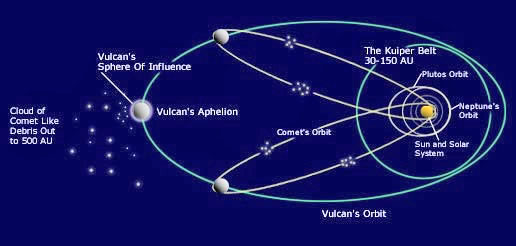
Stony meteorites are five to ten times
more common than metal ones. A meteorite more than 300 meters in
size would throw a thousand times its mass into the high atmosphere.
Half-micron sized debris could remain aloft for over ten years,
causing the oceans to cool and lose their reserves of heat. Fine ice
crystals, which naturally form when temperatures drop below minus 40º C, would no longer be held at bay by heat rising from the
Earth. They would reflect much of the Sun’s radiation back into
space causing the Earth to remain suspended in an Ice Age.
Less frequently, iron meteor strikes form heat-absorbing metallic
dust that prevents the fine ice crystals from forming. The Earth
would warm, signaling the start of an interglacial period. Such a
strike would quickly melt ice and cause another catastrophe. Such an
impact could be responsible for the extinction of 32 genera of mega
fauna around 11,600 years ago at the end of the Ice Age. The rapid
thaw melted the permafrost turning their tundra into a huge bog.
This is why these giant mammals (e.g. wooly mammoths) are found
buried upright. Well fed, they sank as the ground beneath them
flooded and thawed.
Hoyle’s theory was criticized because geologists considered that
the
Ice Ages of the Pleistocene occurred on a regular or periodic basis,
and Hoyle’s proposed meteor strikes were expected to occur randomly.
In truth, there may be nothing random about them. Geologists agree
that glacial periods last about 100,000 years, whereas both
interglacial periods and periodic fluctuations of temperature within
the glacial period (bringing about the advance and retreat of
glacial ice) each last about 10,000 years. NASA’s David Morrison
notes that the chance that civilization may sustain a serious meteor
strike could be as high as 1 in 10,000. Some pre-historians think
our current warm age will not last much longer.
Christ acknowledged Noah’s flood and associated it with fire and
sulfur falling from the sky on Sodom. Curiously, Hoyle takes pains
to extricate his theory from Noah’s flood. He misdates it to 5,000
BC rather than to 3,000 BC, as do most theological sources.
Hoyle
also claims, without basis, that a cave (not an Ark) was involved.
Hoyle’s downplaying / dismissal of Noah’s Ark is very curious,
especially since it was found circa 1948 and investigated in the
1980s by Fasold, Windsor and Wyatt.12
Was Hoyle apprised of a secret
program, since he was the "ace" astronomer of the UK? Geologists
cited in a book he references recorded a mini Ice Age about 5,300
years ago, near the anticipated date of the strike causing a
worldwide flood. We think the Great Flood occurred 3195 BC based on
matching theological and tree ring data.
Researchers in Utrecht have identified six relatively recent
magnetic "excursions" during which the magnetic pole moved a large
distance (45 degrees or more) away from the geographical pole, and
then returned. Each of these events lasted about 5,000 years
(Vulcan’s period). Magnetic excursions are failed attempts at
magnetic reversal. When they occur, the strength of the magnetic
field falls dramatically. Earth’s magnetic field is currently
diminishing and there is mounting evidence of increased aurora
activity at lower latitudes. We think the magnetic field changes are
related to Vulcan’s aphelion and perihelion. They are
"cemented in" by comet impacts.13
Tales of
the Survivors
According to Hoyle, the change from Ice Age to warm age took only a
decade. This must have proven nearly as disastrous for humans as for
the mega fauna that were driven to extinction. Reversals of the
Earth’s magnetic field when Vulcan is near aphelion could cause
penetration of high-energy ions from the Van Allen belts. These
would produce biological mutations, new strains of bacteria and
viruses, and the combined effects of chemical, nuclear and
biological warfare.
Strike data from ancient cultures have been recorded worldwide.
Allan and Delair in
When the Earth Nearly Died have catalogued over
five hundred legends depicting this catastrophe. The most popular
topic in ancient legends is the deluge, but in many the deluge
occurs after a conflagration or firestorm. When mentioned in pairs,
the firestorm precedes the deluge, and the water extinguishes it.
Also mentioned is ice hail, rains of blood and solid material (like
stones), as well as tsunamis and boiling lakes and rivers. The
average date of this event, derived from all sources, is 11,581
years ago.
A sea of crystal - the comets’ debris fields - preceded the comet
Phaeton. They fell first and kept falling even after the comet’s
main body impacted. Raindrops ranging from the size of a man’s head
to that of a wigwam were reported, as well as 50 kg. ice hail.
Frozen gases (dry ice) could fall into bodies of water and give the
appearance of boiling. Bones of late Pleistocene animals encountered
in drift deposits are frequently iron stained.
Bone breccias are
often strongly ferruginous and silicified. This material may have
come from the debris field, or the main body of the comet itself, or
both. A metal core comet striking the Earth would inject large
amounts of metal dust into the stratosphere, creating a "sky of
brass" and turning the icy tundra into a muddy swamp. These legends
support Fred Hoyle’s theory that a metal meteorite caused the great
mega fauna extinction circa 11,600 years ago.
Both the
Navajos
and Choctaw, who are found in Arizona and Oklahoma
respectively, tell tales of a giant tsunami. These areas are far
inland, and it would take quite a tsunami to reach it. However, the
American Indians were nomadic, and could have originally lived
closer to the ocean. The Koran states that the wave bearing the Ark
united with other waters from more southern latitudes.
Can We
Believe It? You Bet Your Life!
Can this work dealing with the cyclic annihilation of mankind be
taken seriously? All ET-related material is assumed not to be a
hoax. The only measure of reasonability of "pseudo-science" data is
its link to accepted data. Vulcan is linked to valid scientific data
like the Akkadian seal, the IRAS search for a Protostar and the
resulting IRAS object. It is also found in "pseudo-scientific" data
like
Betty Hill’s star map,
Crop Circle T367 and an unpublished ET
description of the solar system.
Vulcan’s orbit was (partially)
derived by Chinese astrological techniques, so it is considered a
"pseudo-science" result. But it is linked to Forbes’ hypothetical
planet’s orbit and geo-climatological data, both deduced by standard
scientific methods. The comet’s revisit cycle is linked to Vulcan’s
5,000-year period and to the 10,000-year long interglacial periods
(by a 3:2 orbit resonance). While the precise threatening impact
dates are "pseudo-scientific" data, they fit within the
mathematically projected window of a past impact event.
Humankind may be so decimated by impacts in this century that we
could not recover enough to survive the massive strikes predicted to
follow in the next 1800 years.14 Those impacts will boil away the
seas and reform the surface of the Earth. All life will be
eradicated down to the last microbe.
Given our leaders’ deceptive
nature, only
the chosen elite will survive the impending impacts,
thus eliminating the technological base required to impede the later
threats. Human beings could end up viewing a "New Heaven and New
Earth" (2 Peter 3:13 and Revelation 21) after incarnating in a new
body type in a different solar system.
Footnotes
1. Danjo, Yari;
ASTRO-METRICS of Undiscovered Planets and
Intelligent Life Forms. Danjo’s theory accurately
predicts the orbits of solar planets and planets (and stars) in
nearby star systems. Danjo postulates that the solar system was
seeded and formed with the aid of a solar companion. We call it
Vulcan because the Theosophist Madame Blavatsky called it Vulcan
and taught us how to define its orbit.
2. See
Earth’s Bleak Future.
3. The Astrophysical Journal 290; L5 -L8, 1985 March.
http://adsbit.harvard.edu/cgi-bin/nph-iarticle_query?1985
ApJ...290L...5Hname.
4. See
www.barry.warmkessel.com/barry/2002Paper.html.
Astronomical events relating to Jesus/Christ, Gutama/Buddha and
the Dawn Of Mankind are defined. See
www.cdi.org/russia/johnson/6018-7.cfm.
Stars Aren’t Smiling Down on 2002, according to Sergei
Bezborodny, head of the astrology center at the Central House of
the Russian Army.
5. See
Vulcan, Comets and the Impending
Catastrophe
6. What Would Happen if a Massive Oort Cloud Comet Strikes Earth?
Answer: Venus. See
http://personals.galaxyinternet.net/tunga/Venus.htm
and
http://csep10.phys.utk.edu/astr161/lect/venus/surface.html.
7. This theory is supported by ten substantial abduction cases,
where ETs warned of an impending catastrophe. Six of these
warnings indicated impending meteor or comet impacts.
8.
The Kuiper Belt
9. Tollmann, Alexander,
www.kheper.net/ecognosis/essays/Meeting_History.html.
10. See
The Hill Aliens
11. See Current Evidence of Septimus’ and Vulcan’s Mass and
Orbit,
www.barry.warmkessel.com/barry/1999Paper.html#2,
Figure 5A: An Extraterrestrial Alien Description of Our Alphabet
and Solar System.
12. See
Noah’s Ark It’s Geometry, and Noah’s
Vessel 24,000 Deadweight Tons. See also, Fasold,
David, The Ark of Noah, 1988, and Ron Wyatt’s
www.arkdiscovery.com.
13. See
www.barry.warmkessel.com/barry/8related.html#a and b
for discussion of the impending change of Earth’s magnetic
field. See also, New Insight Into Earth’s Magnetic Quirks,
http://abob.libs.uga.edu/bobk/ccc/cc033099.html.
14. The passage of the comet swarm that caused the Great Flood
is estimated to reoccur in 3823. See
Earth’s Bleak Future and 1999 Paper
References
-
"Did a Comet Swarm Kill the
Dinosaurs?" Sky and Telescope,
http://skyandtelescope.com/news/current/article_738_1.asp.
-
Allan, D. S. and J. B. Delair;
When The Earth Nearly Died: Compelling Evidence of a World
Cataclysm 11,500 Years Ago, Gateway Books, 1994.
-
Andrews, Colin. CPR
International Newsletter, Autumn/Winter, 1995/1996,
1996/1997. The T367 crop circle was shown on Sightings,
narrated by Peter Sorensen. See also
www.vitalspark.org/vitalspark/210cc02.html.
-
Beishline, Blackburn and
Warmkessel. Dowsing For Extraterrestrials, American
Association Of Dowsers, Fall 1995.
-
Chapman, Clark and David
Morrison, Cosmic Catastrophes, Perseus Publishing, 1989.
-
Danjo, Yari;
ASTRO-METRICS of Undiscovered Planets
and Intelligent Life Forms, 1994.
-
Drosnin, Michael. The Bible
Code; Simon & Schuster, NY, 1997.
-
Fasold, David, The Ark of Noah,
Wynwood Press, New York, 1988.
-
Forbes, George, On Comets, Proc.
Royal Astronomical Society, Edinburgh. 1878.
-
Nostradamus: The
Complete Prophecies
-
Hoyle, Sir Fred. ICE The
Ultimate Human Catastrophe, Continuum Publishing, NY, 1981.
-
Jenkins, John. Tzolkin:
Visionary Perspectives and Calendar Studies. Borderline
Sciences. 1994.
-
Lindemann, Michael, Video. UFOs
and The Global Situation; CNI NEWS.
-
Pickering, William H. "A Search
For A Planet Beyond Neptune." Annals of the Astronomical
Observatory of Harvard College, Cambridge, MA.
-
Sitchin, Zecharia.
The 12th
Planet, Avon reissue, 1999.
-
Van Flandern, Tom. Dark Matter,
Missing Planets & New Comets, North Atlantic Books,
Berkeley, 1993.
|





